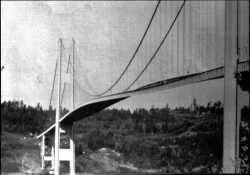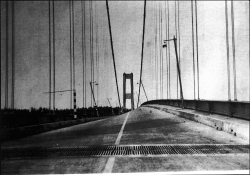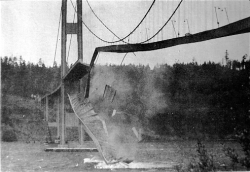


In this project you will study models of the failure of the Tacoma Narrows Bridge, the first suspension bridge across the Narrows of Puget Sound in Washington State. It connected the Olympic Peninsula with the mainland of Washington. The bridge's main span was 853 meters.
These are uninteresting facts unless you know the fate of the Tacoma
Narrows Bridge. The bridge is famous because on Nov. 7, 1940, four months
after it opened, it collapsed in a 68 km per hour wind. Pictures of the
bridges final moments have been shown many times, including on a recent
television commercial for cassette tapes. Click here
to see a
10-second video clip of the bridge collapse.
Immediately prior to the bridges failure, it was undergoing large twisting or torsional oscillations. This is shown in left-most figure below. When the twisting motion was at the maximum, shown in the middle figure, one side of the span was 8.5 meters higher than the other side. Shortly before 11 o'clock in the morning, a large piece of concrete dropped out of the roadway, and a few minutes later a 180 meter section of the bridge collapsed, shown in the right-most figure below.
 |
 |
 |
Until the collapse of the Tacoma Narrows Bridge, suspension bridges were built with little theoretical understanding of their dynamics. These bridges exhibited interesting behavior:
Your project is to study a sequence of models that incorporate more and more engineering analysis into this problem. We will see models that dissipate small oscillations, models that allow large oscillations and finally models that transform vertical oscillations into torsional oscillations.